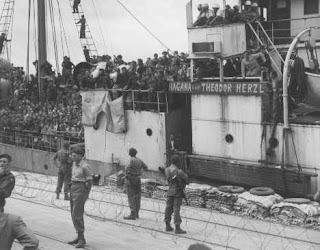SAVIOURS ON THE SEAS
The Foundation “Aliyah Bet” became the code name
given to illegal immigration Jews to Mandatory Palestine between 1934 and 1948,
most of whom were Holocaust survivors and refugees from Nazi Germany. It
became one of the principle ways of rescuing Jews during World War II.
All told, a fleet of 60 ramshackle ships transported
more than 60,000 “illegal immigrants”
from European ports between 1946 and 1948 in severely unsafe and dangerous
conditions.
Immediately after the War of Independence, Aliya Bet
was resumed on an ambitious and urgent scale. Its intensification, beyond the
objective of rescuing Holocaust survivors from all over Europe, was adopted as
a tactic in the organized Jewish resistance in Palestine - designed to end
British rule.
Over 32,000 “illegal” immigrants who
sailed from post-Nazi Europe for Palestine travelled on vessels bought in the
US and manned by American volunteer sailors. The ten
American "big ships brought to Palestinian waters 43 per cent of all the
Holocaust survivors rescued in that period of time. The ships were purchased by
American philanthropists. The crews were mostly American and Canadian.
The first man to hold the equivalent rank of "admiral" was Paul Shulman of New York City. Shulman was an Annapolis graduate and directed the purchase of most of the 12 Aliyah Bet (clandestine immigration) ships purchased in the U.S. to rescue Holocaust survivors. Eventually, he became the founder and first commander of the Israeli navy.
During World War II, American born Murray S. Greenfield served in the Merchant Marines, and, by late 1946, someone told him about “Aliyah Bet”. He became one of 250 American volunteers who sailed on so-called “rust buckets” – vessels that were not made for long journeys – between 1946 and 1948, rescuing more than a third of Holocaust survivors from ports in Europe to Cyprus, Tel Aviv and Haifa.
“We created
the Jewish state, with the help of these ships,” Greenfield says. “Of the
70,000-odd Jews who were brought to Palestine after World War II and before the
state, over 50 percent came on American ships sailed by some 250 young men who
were volunteers like myself.”
After
spending time in a British prison on the isle of Cyprus, Greenfield moved to
Palestine at the age of twenty. He went on to devote his life in various public
services. Among many other endeavours, he founded the Gefen Publishing House.
He helped immigrants from North America as a founding member of
AACI (American
and Canadians in Israel), and played a leading role in the
aliyah of Ethiopian Jewry.
All five fighting ships in the Israeli Navy were
purchased in America, initially as Aliyah Bet ships. Americans and Canadians
with World War II experience trained Israeli crews in command and maintenance.
As the years went on, the story of Aliyah Bet became an important element in the history of modern Israel. Yet the role of Americans in the historic undertaking remained a virtually unknown episode. The truth about the role North American volunteers played in Aliyah Bet was lost for four decades.



Comments
Post a Comment